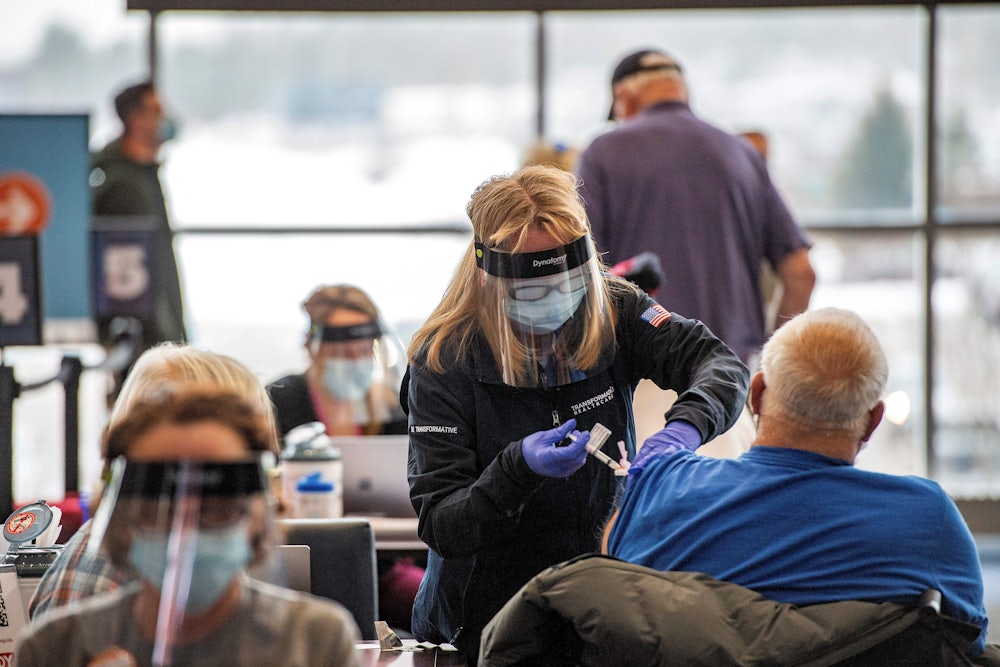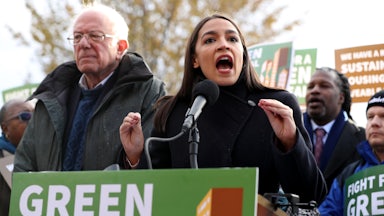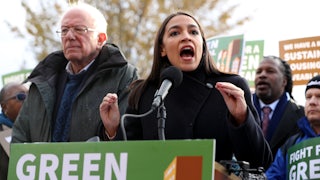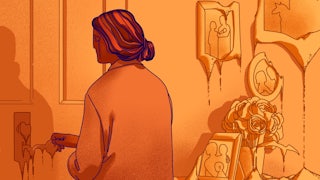Carolyn Bennett Glauda, a librarian in Beacon, New York, got her Covid-19 shot at an abandoned JC Penney. The store went out of business around the beginning of the pandemic. But when she entered, she saw a cheery, volunteer-filled vaccination hub adorned with balloons. Glauda almost didn’t recognize the space until she was sent to a post-shot waiting area and noticed a sign indicating it was once the Junior’s section. “That’s the most joy this geographic location has seen in fifteen years,” Glauda told me. “The energy of the people overwhelmed the dreariness of the location.”
Across the U.S., people are getting vaccinated in dormant horse racetracks, empty baseball stadiums, megachurch parking lots, Target dressing rooms, and abandoned shopping malls. “They’re the kind of places that don’t even register as places, because they’re so peripheral, just part of the sprawl,” said Brandon O’Brien, who lives in Phoenix and got his Covid-19 shot at 5 a.m. in a drive-thru in the parking lot of Cardinals Stadium in Glendale, Arizona. “They’re not remarkable, until they become meaningful.”
Or until 13 months of social distancing renders them tantalizingly unfamiliar.
“It’s like I went to Tibet or something,” said writer Michael Robbins, who ventured to an abandoned K-Mart for his Covid-19 shot after being mostly homebound for the past year. “Being able to go out of my normal range is an experience I used to take for granted.”
Donning an N95 and face shield, Robbins was relieved and disoriented by the stranger-than-fiction reality of receiving a miraculously effective vaccine alongside 100 or so masked strangers, spaced six feet apart, in the husk of a big box retailer. “I was feeling euphoric,” he told me, “and terrified.”
Robbins’s tweets about his vaccine experience inspired hundreds of strangers to share their own surreally mundane vaccine backdrops. People have received Covid-19 vaccines on the beachfront (with an ocean view), at closed amusement parks (rollercoasters paused in the background), and at least one former Charlotte Russe (with an observation area staged in the nearby mall food court). There have been distribution sites at elevator factories and fairground cattle barns, in empty airport hangars, multiplex movie theaters, box gyms, and race car tracks. Some shots have been given at bus stations, others inside of parked buses.
Some strangers described moments of pure joy, like getting the vaccine at an old Toys “R” Us or the same arena where they saw Van Halen play 40 years ago or the banquet hall of a Catholic church, with a disco ball still up and Outkast blasting. One woman shared that her teenage daughter was getting vaccinated at the same clinic where she herself went for prenatal appointments when she was pregnant. Another person received their shot where they would’ve had their graduation ceremony if the virus had not intervened.
Others found these sites of salvation disorienting, dystopic, or hilarious: under a highway overpass, a night club that never opened because of Covid-19, a 2 a.m. appointment at a post office in the Bronx, the visitation room of the prison where Mike Tyson served time.
The coronavirus rearranged normalcy beyond recognition, probably even beyond restoration. Perhaps it’s fitting that, as we reclaim it, we’re transforming the mundane into the monumental.
“I got vaccinated in a busy Rite Aid, just a few feet from the greeting card aisles and St. Patrick’s Day paraphernalia,” one Twitter user shared. “After months & months of longing for that day, it was weirdly anticlimactic. Yet that Rite Aid now feels like a holy, sacred place to me.”
Across modern history, epidemics have reconfigured our notions of human microgeography. “They always have a spatial aspect,” Graham Mooney, a historian of medicine at Johns Hopkins University, told me. “Some of it has to do with the biology of the disease,” he explained, like social distancing during an infectious airborne outbreak. “But some of it has to do with negotiation of personal and public spaces.”
We have gone through innumerable psycho-geographical somersaults since the beginning of the pandemic. Bedrooms became offices. Homes became restaurants. Convention centers and ships became hospitals. Hospitals became warzones. Trucks became morgues. Storefronts became ghost towns. Stadiums became election sites. “Covid has opened up empty spaces in a way that I can’t think of another epidemic that did that,” David Jones, a Harvard University historian of medicine, told me.
And, now, many of the spaces depopulated by the virus are being repopulated by vaccine drives to combat it—especially sites like defunct stadiums and malls that offer the benefits of public transportation, handicap accessibility, and ample parking.
In 1988, historian John C. Burnham insisted that we should be measuring a disaster’s significance by examining its social effects. Aside from the deaths and physical destruction, he wrote, “natural disasters often have the accidental effect of revealing the makeup of the social fabric as people reacted under extreme stress.” Or as Jones put it a month into the Covid-19 pandemic, “Epidemics provide a sampling device for social analysis. They reveal what really matters to a population and whom they truly value.”
So what does it mean that this historic vaccine drive is being housed in spaces of abandonment and neglect? “It says a lot about the pandemic itself,” Mooney said, and about how far it pushed our healthcare system’s capacity for conducting medicine normally. It also reminds us of how possible it would be, with enough will, to repurpose geographic and architectural surplus into accessible healthcare clinics or shelter for the unhoused. “I think it’s innovative. Some of those spaces and places are hideously underused,” Mooney said.
Early on in the pandemic, I couldn’t stop poring over ghostly photo slideshows capturing the world’s busiest places drained of humanity. In the stories of people who got vaccinated in these improbable sites, I discovered the reverse: people are now publicly offering up their individual bodies for our collective health (okay, for their own benefit as well), and doing so in places we had previously abandoned both psychically and physically.
After a war or a natural disaster, there are ruins to sift through, reimagine, and reconstruct. But for us, the physical spaces ravaged by Covid-19 are intact but hollowed. Somehow, restoring the shell of a before-times place by transforming it into a hope-filled vaccine hub feels restorative in and of itself. When someone passes through, they receive not only a potentially life-saving drug but a soothing of the psychic distortion wreaked by the last year.
When Glauda’s husband got vaccinated at a CVS inside of a Target, she was glad to notice the full shelf of toilet paper near him—unthinkable last spring during the shortages. “Things are looking up,” she thought. Robbins said he reveled in making small talk with the others waiting in line in his abandoned K-Mart vaccine site. “It’s remarkable I remember how to do that,” he told me.
And then there’s the miracle of the vaccination itself, an act that cannot be done remotely and necessitates human contact at a time when meaningful social interaction has been mostly out of reach through near-constant overlapping crises. It is a reminder that touch itself is a form of place—the one that maps the geography of humans occupying the exact same space at precisely the same time. It is the joy of union, regardless of where you happen to be standing.








